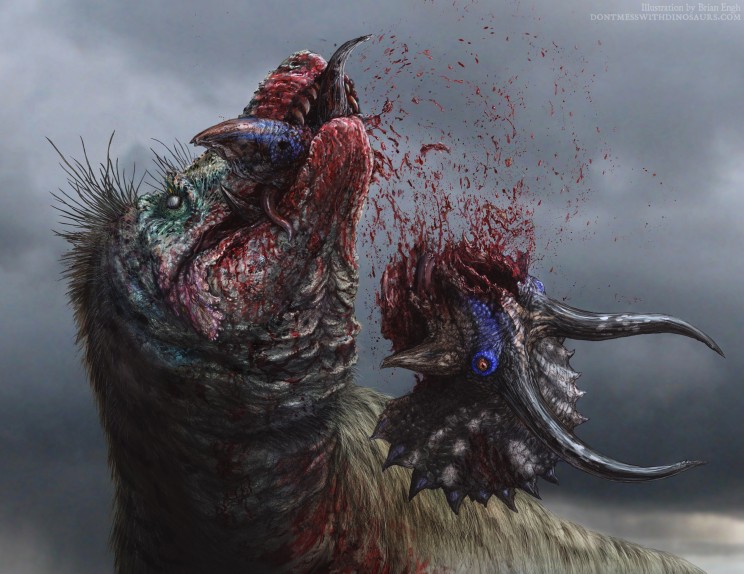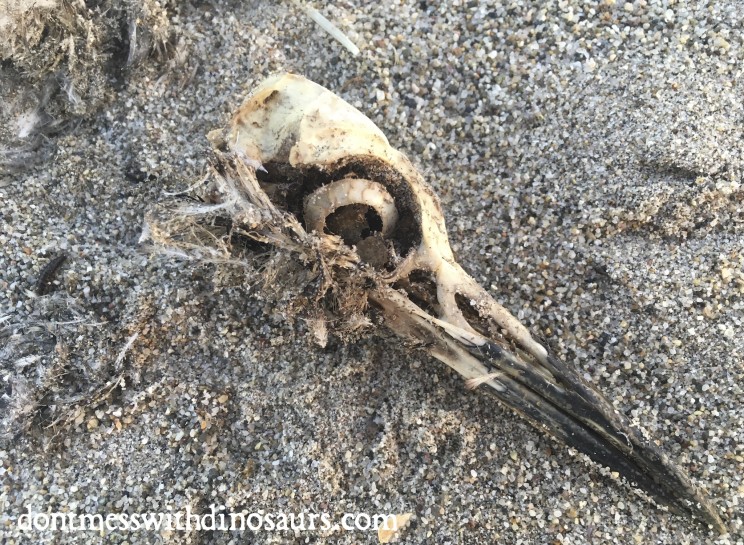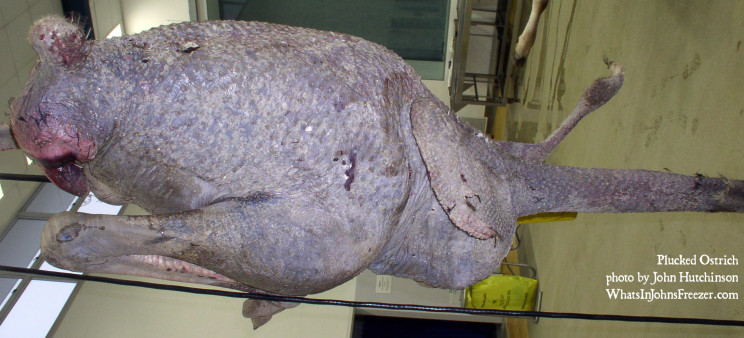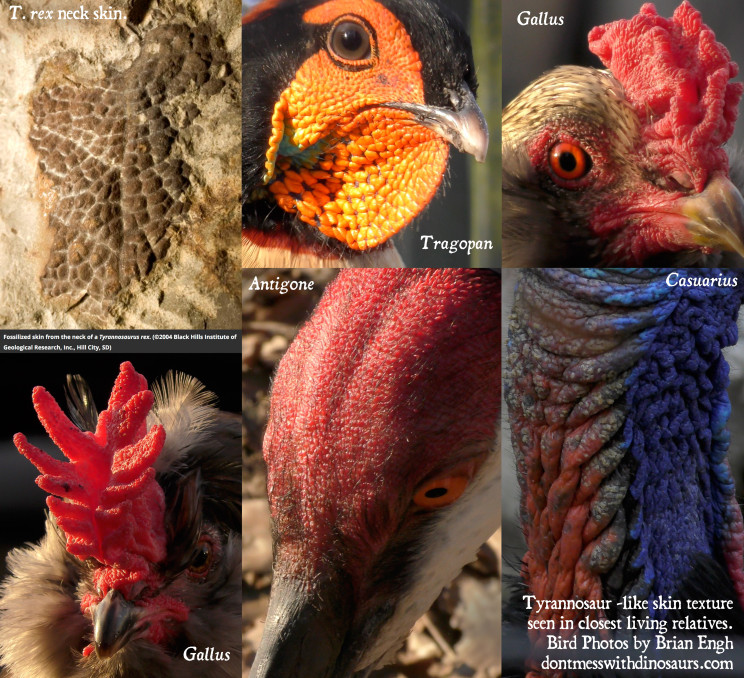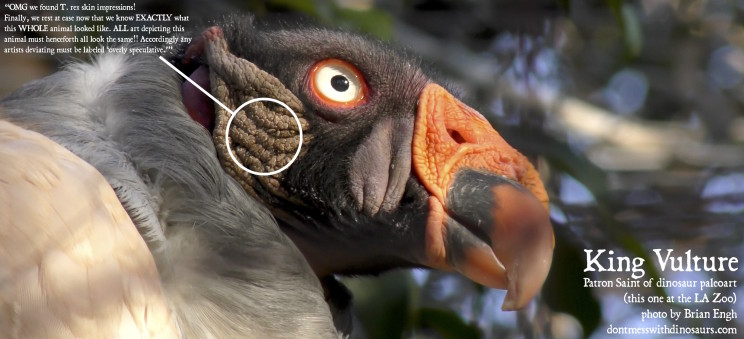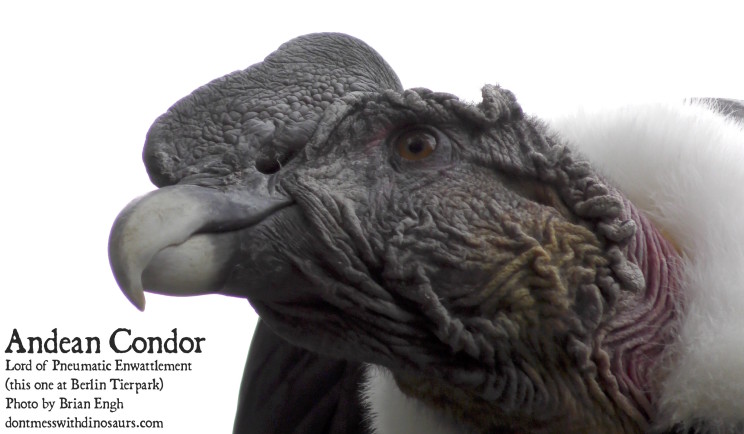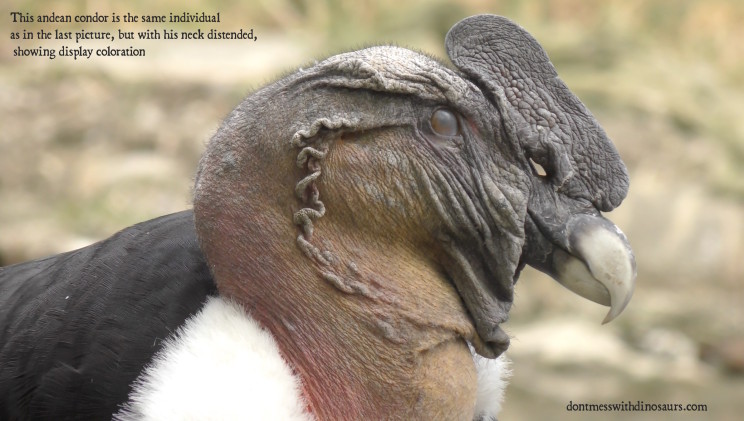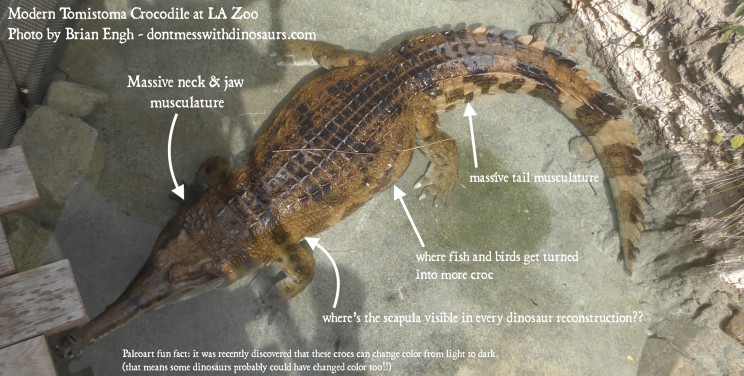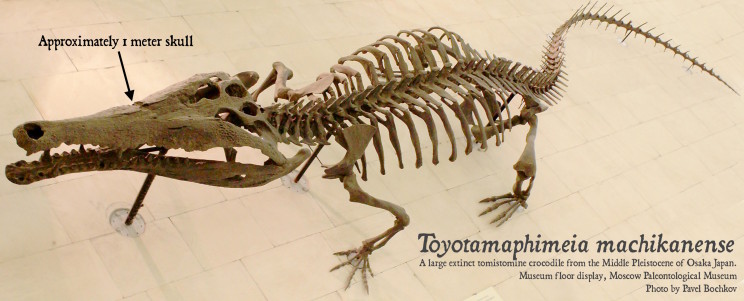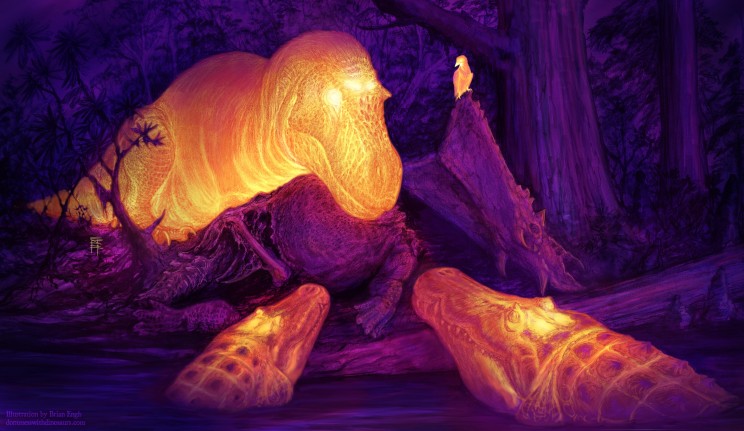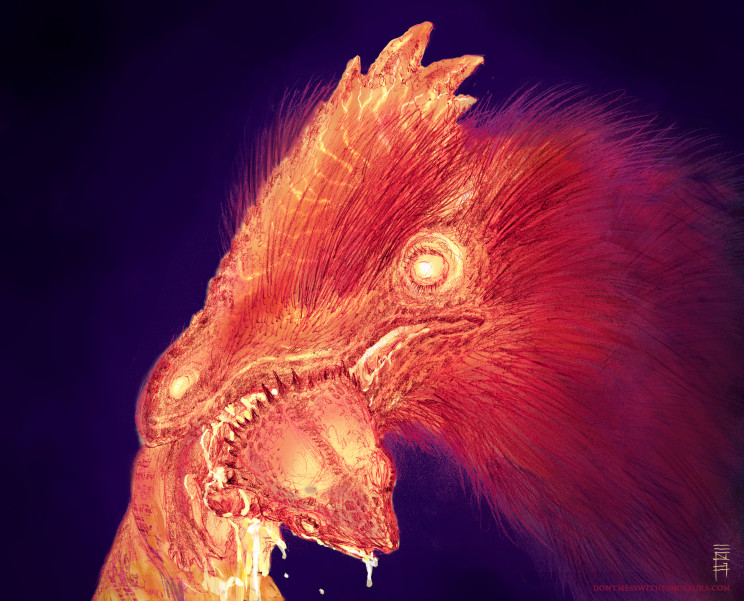T. rex’s skull shattering bite
The architecture of the Tyrannosaur skull was shaped by millions of years of evolution toward developing bigger jaw muscles, stronger skull bones, and increasingly thick, robust serrated teeth capable of puncturing through bone. From huge coprolites (fossil poops) packed with mulched bone, to huge shed tyrannosaur teeth lodged deeply into other dinosaur’s bones like they’d been shot into the animal with a rifle, there is a lot of evidence suggesting that T. rex had what was probably among the most powerful bites we know of from the animal kingdom, and perhaps the strongest ever among terrestrial animals. Some hard biting modern dinosaurs – parrots specifically – exhibit extensive cranial kinesis – or the ability of the bones of their skulls to flex and move. A bunch of other animals, from fish to reptiles to birds and some other dinosaurs show clear signs of cranial kinesis, so that lead Ian Cost & his team to try and figure out whether this was going on with Tyrannosaurs. In a new study, Dr. Ian Cost & colleagues test whether or not cranial kinesis was part of the suite of biomechanical adaptations that enabled T. rex to bite so bafflingly hard./>Turns out, probably not. Their computer models indicate that the numerous bones in T. rex’s head must have been tightly fused when the animal was alive, more like crocs and turtles in that regard than birds.
This new illustration was commissioned by one of the coauthors, Dr. Casey Holliday who is/was several of the other author’s PhD advisor. I gotta give an extra big shoutout to Casey for supporting his Phd student’s work even after they move on from his lab to their more permanent career positions. Not all academics are willing to invest in paleoart, especially for papers they’re not lead author on, so i really applaud his willingness to help push the scicomm for this paper with original art inspired by this new science.
I expect a few people will balk at this art either because it’s gory and/or because my T. rex reconstruction doesn’t look like all the other more slender, classically reptilian-looking tyrannosaur reconstructions people are used to, and that’s fine, I’ve been balking at all that paleoart ever since I first saw the grotesque relics of the T. rex named Sue back in 1999. Unfortunately it seems that in typical fashion for internet discourse all discussion of Tyrannosaur reconstruction has boiled down to two apparently irreconcilable sides SCALY vs. FEATHERY. I would like to make it extremely clear that I’m not on either side because I don’t see them as mutually exclusive, and honestly we don’t even know what the few sparse Tyrannosaur “scales” really are.
I encourage anyone interested in paleontology or paleo reconstruction to walk in a river bed or along a beach and look for carcasses. When you find a carcass, take a picture. Keep re-visiting it for several weeks, taking pictures each time. See how long it takes for natural deposition to bury it (or if it gets buried at all) and watch how it falls apart in the process. Studying this process is called taphonomy. If the carcass is from a bird or a mammal see what falls off first and what actually gets buried. From what I’ve seen, light weight floofy integument often detatches and blows away on the wind or floats away when water transports or begins to bury carcasses.
This simple observation has bearing on how we interpret dinosaur family trees in terms of where we might expect to see feathery structures. People seem to have no problem with the fact that mammoths and woolly rhinos frozen in permafrost – arguably the best preserved fossils of any extinct megafauna ever, and only tens of thousands of years old – have very often lost most or all of their hair.
Whooly rhino with almost no hair left…
Consider that the ONE and only highly complete large tyrannosaur fossil yet found that preserves extensive body covering is a 20 foot Yutyrannus and it’s completely floofy with feathers(and, imo still terrifying af). Now imagine how long it would take to bury a 7 ton tyrannosaur… Which begs the question what would the skin texture of a dead Tyrannosaur that all the hair-like feathers fell off of look like? Here’s what the largest living dinosaur looks like without it’s feathers:
Huge shoutout John Hutchinson. Image from his blog What’s In John’s Freezer?
Unfortunately the few skin impressions from other large Tyrannosaurs are scattered and tiny and show a texture that could be described as scaly, or that could just as well be described as deeply wrinkly. There is now evidence that the “scales” on birds scales may be derived from reduced feathers, and may likely evolved independent of crocodylian “scales” which are formed in a variety of other ways. Either way, the few tyrannosaur skin impressions looks to me (and others) much more like the tiny wrinkly scales on the legs of birds or the naked wrinkly skin on the necks and wattles of many birds, than they look like crocodilian or lepidosaurian scales.
Little hair-like feathers can sprout between the scale like structures on birds legs, and/or amidst thickened wattly wrinkle-skin. And no, I don’t buy the argument that T. rex lost their feathers because the had larger bodies. By that logic a tiger should be naked (or more naked) than a black footed cat. That’s not how biology works. So, because T. rex are much MUCH more closely related to birds than they are to crocodilians, so I did my best to reconstruct T. rex based on large carnivorous birds that have wrinkly neck skin and have few or no predators…
And that isn’t to say I think this is the ONLY way to reconstruct T. rex. I think it’s entirely plausible that they had independently evolved an integument completely devoid of even vestigial plumage. But we’ve seen that. Like, A LOT. And from where I’m standing neither the phylogenetics, nor modern analogues for those phylogenetics, nor the fossil skin impressions nor taphonomy make that the only unequivocal choice for paleoart reconstruction.
I’m sure some people will think this illustration is just another illustration glorifying predation and gore in paleoart, and on one level they’re totally right. People are compelled by violence, and me more than most. But I think there’s decent reasons to take advantage of that innate fascination with carnage. First, I think it’s important to remind ourselves how tiny and finite we are. For me at least, beholding one of the most extreme predators in earth’s history is a humbling experience, and in no small part due to the fact that my dismembered remains would fit tidily in its crop or stomach. Second, this is a study about biomechanics. Understanding the extremes of biomechanics is one of very few good reasons to study paleontology, as biomechanics have far reaching real-life applications. The biomechanics of T. rex’s jaws evolved so that they could smash the absolute shit out of things. I thus, cordially invite you to do some googles for images of animals with strong bite-forces eating. Try out search terms like “crocodiles killing zebra”, “Hyenas eating”, or “Alligator vs. turtle.” If your internet is like mine you will see ONLY HORRIFYING IMAGES. Alligators & crocs are the only living animals with bite forces approaching tyrannosaur levels of smash, and when they bite turtles the turtles literally POP. It’s fucking gross, but it’s real life.
While you’re at it check out the thickness of the necks and the gular pouches of these animals. These living animal’s skulls – even at the extreme sizes for their species – are much less massive than the skulls of a large tyrannosaurs, and only had a fraction of the ammount of jaw muscle as compared to T. rex. Also the NECK VERTS of mature T. rex are CHUNKY, have broad-based cervical ribs (which are for muscles attaching) and are often horribly gnarled with arthritis. They make the neck vertebrae of big crocodiles look almost *dainty*, and croc necks are surprisingly muscular. Also the big flat plates of bone where the neck muscles attach on the back of Tyrannosaur skulls are VAST, all of which is why my T. wrecks neck got more thickness than most reconstructions.
My work gets labeled as {overly} “speculative” a lot, and I see the word “monster” get used to refer to paleoart with teeth or blood or action in it like it’s a durogatory, but from where I’m standing it really seems like both of these labels are just ways for artists and fans of the art to try and separate things into arbitrary categories that don’t really have any bearing on how scientifically informed a piece of art is. In my view a scaly shrink-wrapped T. rex is also highly speculative. The artist just speculated that for some reason T. rex’s musculature almost didn’t exist or worked according to alternative laws of physics and that its skin covering had evolved into something not clearly suggested by the available fossils. That is a fiction, but so is every other paleoart reconstruction on some level. In mythology monsters are fictional beasts that embody ideas and values. Real data suggested by fossils informs the modern mythology of paleoart. I would argue that my art isn’t any more “speculative” or “monstrous” than images of clean T. rex’s sleeping or gently preening or whatever other cuddly Disney-fied reality people currently think is “counter to the traditional biases”. As best I can tell looking at the available evidence and the incredible fossils we have of T. rex these animals were giant stem-bird weirdos that drove their gnarled fangy smasher faces into things, propelled by stupid-thiccccc super-powerful turkey legs yanked backwards by muscles levering down most of the length of long stiffened crocodile tails. My goal was to make some art that looks like that.
